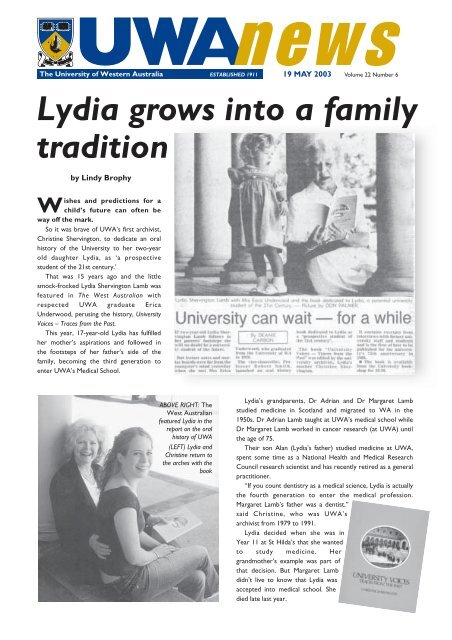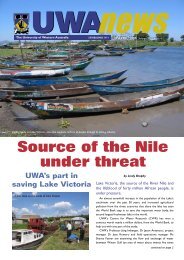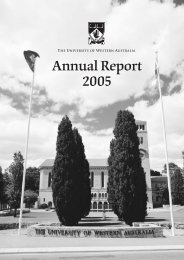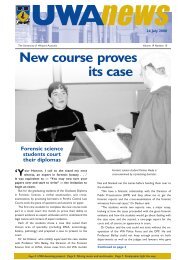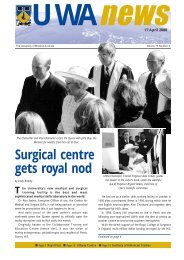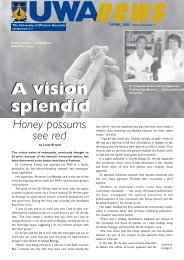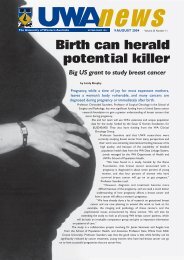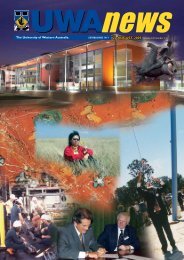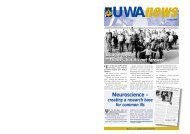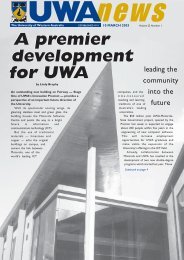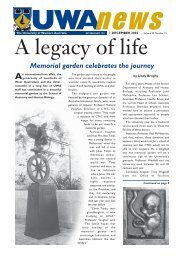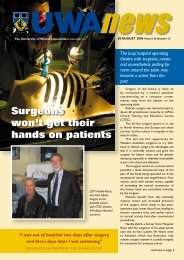19 May: Vol 22, #6 - Publications Unit - The University of Western ...
19 May: Vol 22, #6 - Publications Unit - The University of Western ...
19 May: Vol 22, #6 - Publications Unit - The University of Western ...
- No tags were found...
Create successful ePaper yourself
Turn your PDF publications into a flip-book with our unique Google optimized e-Paper software.
UWAnews<strong>The</strong> <strong>University</strong> <strong>of</strong> <strong>Western</strong> Australia ESTABLISHED <strong>19</strong>11 <strong>19</strong> MAY 2003 <strong>Vol</strong>ume <strong>22</strong> Number 6Lydia grows into a familytraditionby Lindy BrophyWishes and predictions for achild’s future can <strong>of</strong>ten beway <strong>of</strong>f the mark.So it was brave <strong>of</strong> UWA’s first archivist,Christine Shervington, to dedicate an oralhistory <strong>of</strong> the <strong>University</strong> to her two-yearold daughter Lydia, as ‘a prospectivestudent <strong>of</strong> the 21st century.’That was 15 years ago and the littlesmock-frocked Lydia Shervington Lamb wasfeatured in <strong>The</strong> West Australian withrespected UWA graduate EricaUnderwood, perusing the history, <strong>University</strong>Voices – Traces from the Past.This year, 17-year-old Lydia has fulfilledher mother’s aspirations and followed inthe footsteps <strong>of</strong> her father’s side <strong>of</strong> thefamily, becoming the third generation toenter UWA’s Medical School.ABOVE RIGHT: <strong>The</strong>West Australianfeatured Lydia in thereport on the oralhistory <strong>of</strong> UWA(LEFT) Lydia andChristine return tothe arches with thebookLydia’s grandparents, Dr Adrian and Dr Margaret Lambstudied medicine in Scotland and migrated to WA in the<strong>19</strong>50s. Dr Adrian Lamb taught at UWA’s medical school whileDr Margaret Lamb worked in cancer research (at UWA) untilthe age <strong>of</strong> 75.<strong>The</strong>ir son Alan (Lydia’s father) studied medicine at UWA,spent some time as a National Health and Medical ResearchCouncil research scientist and has recently retired as a generalpractitioner.“If you count dentistry as a medical science, Lydia is actuallythe fourth generation to enter the medical pr<strong>of</strong>ession.Margaret Lamb’s father was a dentist,”said Christine, who was UWA’sarchivist from <strong>19</strong>79 to <strong>19</strong>91.Lydia decided when she was inYear 11 at St Hilda’s that she wantedto study medicine. Hergrandmother’s example was part <strong>of</strong>that decision. But Margaret Lambdidn’t live to know that Lydia wasaccepted into medical school. Shedied late last year.
2 UWAnewsVCariousthoughts …Triumphingover distance“Good grief…” a friend said to me as I welcomed himto UWA from Canberra for a pr<strong>of</strong>essional visit. “I’dforgotten how far it is to WA.”I quietly pointed out that it is just as far from WA toCanberra … but I am not sure the fact registered with him ashe continued commenting on how he had taken most <strong>of</strong> theday to reach us.With the new communication technologies distance andtime has been revolutionised. <strong>The</strong> new edition <strong>of</strong> Pr<strong>of</strong>essorBlainey’s famous Tyranny <strong>of</strong> Distance has a new, final chapterreflecting on those dramatic changes in our history.Yet ‘mind sets’ are not so easily changed. And nor are thetime-zones <strong>of</strong> the geography that constitutes a vast islandcontinent such as ours.Paradoxically, the issues are indeed alive again as adimension <strong>of</strong> educational and research policies designed todeal with internationalisation.To ensure quality and competitiveness, national policiesincreasingly focus on priorities, concentration, and linkages.<strong>The</strong> potential for these policies and resources to focus on atriangular axis <strong>of</strong> ‘Sydney-Canberra-Melbourne’ is great.Queensland’s ‘smart state’ strategies have broadened thatfocus. But outside that east coast line, an urgent challengeremains to build a regionally distributed and diversified set <strong>of</strong>research intensive universities and centres.<strong>The</strong> current ‘mapping <strong>of</strong> science’ exercise being conductedby DEST in collaboration with the ARC, AVCC, academiesand PMSEIC — will set the issue for the future squarelybefore us.Our university has a proud history <strong>of</strong> creativity andachievement based on distinctiveness and a sense <strong>of</strong> identityborn <strong>of</strong> a certain separateness <strong>of</strong> WA within the nation.Traditional isolation has spurred on self-reliance. A specialawareness <strong>of</strong> overseas linkages has flourished in the absence<strong>of</strong> easy east-west connections.UWAnewsEDITOR/WRITERLindy BrophyTel.: 9380 2436 Fax: 9380 1<strong>19</strong>2 Email: lindy.brophy@uwa.edu.auEDITOR-IN-CHIEFColin Campbell-FraserTel: 9380 2889 Fax: 9380 1020 Email: ccampbell@admin.uwa.edu.auDesigned and typeset by <strong>Publications</strong> <strong>Unit</strong>, UWAPrinted by UniPrint, UWAUWAnews online: www.publishing.uwa.edu.au/uwanews/All that needs to continue and indeed expand. <strong>The</strong>Founders <strong>of</strong> WA brilliantly anticipated the role <strong>of</strong> an excellentstate university as a powerhouse for the state.<strong>The</strong> great challenge before us a century later is to confrontthe potentially worsening terms <strong>of</strong> policy and investment asthe Commonwealth distributes major infrastructure facilities,research centres and educational programs in ‘places’ andscholarships.We shall need new macro strategies according to thepriorities and objectives contained within the <strong>University</strong>’sOperational Priority Plan. This will ensure that WA is integralto national policy and allocations in both research andteaching.• We must position ourselves through collaborative researchprograms: success in CRCs will be vital (we had no successin the last ARC round).• As a State and a university we need to gain a greater share<strong>of</strong> Commonwealth-funded undergraduate and postgraduateplaces (we are desperately short <strong>of</strong> HECS places… and we failed to gain any <strong>of</strong> the prestigious FederationFellowships).• Establish strategic alliances with significant externalconsortia involved with Innovation, Research andDevelopment.• Lobby strongly for a share <strong>of</strong> the hubs in technology andinfrastructure to be distributed in the next decade.• Ensure that our State Government and industries provideus with the kind <strong>of</strong> gearing support which will ensurecompetitive bids in public-private grants.<strong>The</strong> has been much discussion about higher education itselfbeing at a crossroads in the Nelson Review, with anappropriate focus on base funding, places, about HECS andefficient governance.Equally at the crossroads is our successful place in the longterm<strong>of</strong> the future <strong>of</strong> the national knowledge culture inresearch and educational programs.That will be the ultimate triumph over distance.Pr<strong>of</strong>essor Deryck SchreuderVice-Chancellor and Presidentvc@acs.uwa.edu.auTHE UNIVERSITY OF WESTERN AUSTRALIA • <strong>19</strong> MAY 2003
Can redwine begoodforyou?Diabeticsneededto test thetheoryResearchers Dr Trevor Mori (centre) and Pr<strong>of</strong>essor Ian Puddey (right)and research nurse Di Dunbar get to know volunteer Peter FarsonUWAnews 3<strong>The</strong> French enjoyment <strong>of</strong> red wine might well be afactor in their lower rates <strong>of</strong> heart disease, whencompared with other European countries.But Australian health pr<strong>of</strong>essionals want more than anecdotalevidence or cultural clichés. <strong>The</strong> ‘French paradox’ is under themicroscope in the School <strong>of</strong> Medicine and Pharmacology, with astudy aimed at shedding new light on the effects <strong>of</strong> red wine onblood pressure and cholesterol.Research fellow Dr Trevor Mori and Pr<strong>of</strong>essor Ian Puddeyare calling for volunteers to help them with their research atRoyal Perth Hospital.But the volunteers need to fit very specific criteria.<strong>The</strong> team needs about 35 participants who haveType 2 diabetes, who are aged between 40 and 70years, and who drink at least one or two glasses <strong>of</strong>red wine each day.“We know a great deal about the relationshipbetween alcohol consumption and blood pressure,but we know very little about the overall effects <strong>of</strong>red wine in particular on blood pressure, blood lipids(cholesterol) and blood glucose in people with Type 2diabetes,” Dr Mori said.“We have chosen to work with diabetic volunteersbecause they already have an increased risk <strong>of</strong> heartdisease. <strong>The</strong>y are predisposed to high blood pressure,they have higher blood sugar levels and higher clotting levels.“<strong>The</strong>y also tend to have higher levels <strong>of</strong> the so-called badcholesterol,” he said. “And they are the people who stand tobenefit the most from this research. To our knowledge, this isthe first study <strong>of</strong> its kind in the world.”It is the most recent in a series <strong>of</strong> studies by Dr Mori andPr<strong>of</strong>essor Puddey into diabetes and methods <strong>of</strong> complementingdrug treatment for Type 2 diabetes by targeting nutrition andlifestyle factors.<strong>The</strong>y have previously examined and shown benefits <strong>of</strong> acombination <strong>of</strong> fish in the diet and aerobic exercise, and thepurified marine omega 3 fatty acids, EPA and DHA.Dr Mori said there were suggestions that red wine had alesser effect on blood pressure than other alcohol. “This ispossibly because <strong>of</strong> a protective factor <strong>of</strong>fered by the high levels<strong>of</strong> vasodilator and antioxidant flavonoids in red wine.“We know from test tube studies that this is the case, butwe don’t know it if translates into human studies.”He said the trial would establish the balance <strong>of</strong> potentialbeneficial or adverse effects <strong>of</strong> the regular consumption <strong>of</strong> redwine for diabetic patients.<strong>The</strong> research is supported by the Australian HealthManagement Group Medical Research Fund, with help from theAustralian Wine Research Institute and the Orlando WyndhamGroup.While some people might think it’s a hoot to take part in astudy that requires you to drink two glasses <strong>of</strong> red wine everyday, it is proving difficult to get the right volunteers and theresearchers are still recruiting.<strong>Vol</strong>unteers would have their blood pressure and cholesterolmonitored, over periods <strong>of</strong> four weeks, during which theywould drink moderate amounts <strong>of</strong> red wine, red wine in whichthe alcohol had been removed, and water.If you fit the bill or know somebody who could volunteer,please call research nurse Di Dunbar at RPH on 9<strong>22</strong>4 0242.THE UNIVERSITY OF WESTERN AUSTRALIA • <strong>19</strong> MAY 2003
4 UWAnewsPainless procedure is a prize-winnerPhysicists Tim St Pierre(left), Paul Clark (right)and Wanida Chua-Anusorn celebrate theirwin with Office <strong>of</strong>Industry andInnovation’s AndrewBeveridgeNew medical technologydeveloped in UWA’s School<strong>of</strong> Physics has scooped the pool inawards for commercialisation.UWA spin-out company Inner VisionBiometrics (IVB) was awarded two prizesat the recent Commercialisation Forumand Fair <strong>of</strong> Ideas held in Sydney.Organised by KnowledgeCommercialisation Australasia (KCA)and supported by the FederalDepartment <strong>of</strong> Education,Science and Training under theBacking Australia’s Abilityinitiative, this event showcasedmore than 200 commercialisationprojects from Australianuniversities and research institutions.IVB was awarded two prizes:• Most outstanding researchcommercialisation opportunity in thefield <strong>of</strong> Biotechnology/Life Science —$5000 award, sponsored by MerckSharp and Dohme• Most outstanding researchcommercialisation opportunity froma research institute or spin-<strong>of</strong>fcompany based in <strong>Western</strong> Australia— $5000 award, sponsored by theWA Department <strong>of</strong> Industry andResources.IVB was founded in 2000 followingseveral years <strong>of</strong> intensive researchactivity in the School <strong>of</strong> Physics. Led byAssociate Pr<strong>of</strong>essor Tim St Pierre, theresearch group has developed a noninvasive,patented technique <strong>of</strong> imagingthe liver using Magnetic ResonanceImaging machines.Pr<strong>of</strong>essor Robyn Owens, UWA’s ProVice-Chancellor (Research and“ It confirms that <strong>Western</strong> Australia is capable <strong>of</strong>producing high-technology, growth-oriented companies”Innovation), explained that thebreakthrough identified by the researchteam <strong>of</strong>fered significant benefits.“<strong>The</strong> breakthrough can assistclinicians in the early detection <strong>of</strong>diseases characterised by liver ironoverload such as hemochromatosis,thalassemia and hepatitis C. <strong>The</strong> currenttechnique to measure liver iron levelsrequires a needle biopsy, which is bothpainful for the patient, notrepresentative or particularly accurate,and carries significant heath risks.“<strong>The</strong> <strong>University</strong> is immensely proud<strong>of</strong> what has been achieved so far, andhas high expectations for the future <strong>of</strong>IVB. <strong>The</strong> combination <strong>of</strong> a high qualityresearch team, strong intellectualproperty coupled with a ‘hands-on’investor will help to ensure the longtermsuccess <strong>of</strong> the venture,” Pr<strong>of</strong>essorOwens said.“As with all our research groupsundertaking commercialisation projects,the Office <strong>of</strong> Industry andInnovation (OII) hasworked very closelywith the IVB team.From developing therequired investormemoranda andbusiness plans, to approaching venturecapital organisations, OII assisted IVBevery step <strong>of</strong> the way.”Director <strong>of</strong> OII and Vice-Chair <strong>of</strong>KCA, Dr Andy Sierakowski said thatKCA was a key industry organisationin the field <strong>of</strong> technologycommercialisation : “For IVB toreceive two awards in what was ahighly competitive field is an excellentresult. It confirms that <strong>Western</strong>Australia is capable <strong>of</strong> producing hightechnology,growth-orientedcompanies that are central to theknowledge economy.”THE UNIVERSITY OF WESTERN AUSTRALIA • <strong>19</strong> MAY 2003
UWAnews 5Teaching from thefoundations up<strong>The</strong>re is more to turning abright graduate into a greatteacher than just making ateaching position available.This is why universities providetraining in foundations <strong>of</strong> universityteaching for new academics. But, untilrecently, foundations programs wereconceived and <strong>of</strong>fered in isolation, albeitat a rapidly increasing rate, at individualinstitutions.UWA’s Dr Allan Goody, a lecturer inhigher education development from theOrganisation and Staff DevelopmentServices, and a colleague, Dr JaniceOrrell, from Flinders <strong>University</strong>,recently convened a national meetingfor education developers who facilitatefoundations programs.Dr Goody and Dr Orrell, whosefoundations programs are very similar,put together a colloquium on thepedagogy, impact and logistics <strong>of</strong> theseprograms. Held at Flinders <strong>University</strong>last month, it attracted 45 academicsfrom 29 universities, including four fromDr Allan Goody …interested indeveloping betteruniversity teachersNew Zealand and one from Canada.Dr Goody said that despite thegrowth <strong>of</strong> foundations programs, therehad been little reference betweenuniversities, regarding inclusions orcollaboration in the development <strong>of</strong>resources. “Evaluation <strong>of</strong> their impacton education quality have remainedlargely within the single institutions.”A central concern at the colloquiumwas the likely position that the imminentNelson Report may have on the initialpreparation <strong>of</strong> academics for theirteaching roles.Another was how to engage differentdisciplines in the development anddelivery <strong>of</strong> such programs to accountfor diverse cultural contexts anddemands.Also significant was the issue <strong>of</strong>which staff should be targeted byfoundations programs.<strong>The</strong> concept <strong>of</strong> the higher degreegraduate winning a continuing positionand being mentored into a new role isnot the prevailing norm. It is more likelythat academics experience long periods<strong>of</strong> sessional employment as tutorsbefore achieving a continuingappointment. By this time, manyteaching habits have been ‘caught’ onthe job.<strong>The</strong>re was also the question <strong>of</strong> inservicefor experienced staff, who aretaking on new responsibilities,knowledge and skills withteaching on-line, <strong>of</strong>f-shoreteaching and supervisinglearning in workplaces.<strong>The</strong>se emerging demandsprovide challenges t<strong>of</strong>oundations programs.A consensus wasreached that little couldbe decided pending therelease <strong>of</strong> the NelsonReport. Conclusions willbe drawn after its release.A forum to follow upthese issues will be run byAllan Goody and Janice Orrellat this year’s HERDSAconference in Christchurch.High qualitylowers theoddsUWA Presscontinues toproduce highquality bookswhich are continuallyshortlistedfor awards.<strong>The</strong> latest on the short lists arethree non-fiction publications and achildren’s book.Bitter Victory: the death <strong>of</strong> the HMASSydney by Wes Olson, is one <strong>of</strong> threebooks shortlisted from 18 nominationsfor the Frank Broeze MemorialMaritime History Book Prize.Frank Broeze was a highlyrespectedpr<strong>of</strong>essor<strong>of</strong> history at UWAwho died in 2001.His passion for andinternationallyrecognisedexpertise inmaritime historyis rememberedwith this prize,sponsored by theAustralian Association for MaritimeHistory and the Australian NationalMaritime Museum.<strong>The</strong> <strong>Western</strong> Australian Premier’sBook Awards always have UWAPress books shortlisted. This year,they are Verticordia: <strong>The</strong> Turner <strong>of</strong>Hearts by ElizabethGeorge and MargaretPieroni, and BloodSweat and Welfare byMary Anne Jebb, vyingfor the non-fictionaward. Verticordia isalso shortlisted inthe Scholarly ReferenceCategoryfor the TREAT awards(<strong>The</strong> Australian’s awards forexcellence in educational publishing).In the children’s book section,Mark Greenwood and Frané Lessac’s<strong>The</strong> Legend <strong>of</strong> Moondyne Joe is up for aprize.THE UNIVERSITY OF WESTERN AUSTRALIA • <strong>19</strong> MAY 2003
6 UWAnewsAlison Fowler hopes toextend her appreciation<strong>of</strong> physics throughanother languageOne <strong>of</strong> UWA’s top physics students is enjoyingstudying German.“Much as I love science, especially astro-physics andparticle physics, studying German is great. It’s such a change,reading and writing about plays and films,” said Alison Fowler.“<strong>The</strong> reason I’m studying German is that there are somany great German physicists and I want to be able to readtheir work and talk to them in their own language,” she said.But before she spends time in Germany, Alison is <strong>of</strong>f toDurham, England, next month, after winning a place at theannual Particle Physics and Astronomy InternationalUndergraduate Summer School.This is the third consecutive year in which one <strong>of</strong> theSchool <strong>of</strong> Physics’ students has been chosen to attend theexclusive summer school. It is also the third time that theUWA student has been the only representative fromAustralia.Only 24 students are invited: 12 from the UK and 12international students. For five weeks, the summer schoolAlisonmakesit threein a rowbrings together these young adults who are seriouslyconsidering a career in either astronomy or particle physics.Two weeks <strong>of</strong> concentrated lectures are followed bysupervised work on a project with a leading physicist.<strong>The</strong> students will then visit CERN, the European Centreor Research in Particle Physics, in Geneva. CERN was thebirthplace <strong>of</strong> the World Wide Web. “I’m hoping the summerschool will help me to make a decision about my futuredirection in physics because, right now, I’m not sure whetherI want to follow astro-physics or particle physics,” Alisonsaid.Head <strong>of</strong> the School <strong>of</strong> Physics, Pr<strong>of</strong>essor Ian McArthurcongratulated Alison and thanked her for keeping up theSchool’s fine record.While most <strong>of</strong> her expenses will be paid, Alison has t<strong>of</strong>ind part <strong>of</strong> the airfare herself and is looking for sponsors tohelp her get to the summer school. If you can help or haveany suggestions for her, contact Alison atfowlea01@tartarus. uwa.edu.auAnti-warsentimentsan electronic alternativeAlthough the war in Iraq has ended, George W Bush’s waron terrorism is on-going — and fine arts lecturer PaulTrinidad has created an avenue for teenagers to expresstheir thoughts and feelings about war, conflict andterrorism, through the preferred vehicle <strong>of</strong> theirgeneration, the electronic media.“Back in March, the Minister for Education, Alan Carpenter wascalling for high school students to stay at school and not to joinanti-war protests during school hours. I responded to that call andworked on this project, which I’ve called the Horrors <strong>of</strong> War, gettingit ready to take <strong>of</strong>f at the start <strong>of</strong> this new school term. As it pansout, it is too late to <strong>of</strong>fer to high school students as an alternativeto joining sometimes illegal protests against the horrors <strong>of</strong> war inIraq,” Mr Trinidad said. “But, with the on-going threat <strong>of</strong> the waragainst terrorism, this project is still valid.”He has set up a virtual gallery which gives high school studentsthe opportunity to produce and exhibit work reflecting theirTHE UNIVERSITY OF WESTERN AUSTRALIA • <strong>19</strong> MAY 2003
UWAnews 7EXPOsing the <strong>University</strong>Ever had a neighbour or friend ask: “But what doyou really do at <strong>University</strong>?”Here’s your chance to show them. UWA’s EXPO 2003 is onSunday August 31 and work is already under way to show <strong>of</strong>f thecampus and its faculties to their best advantage.Every year, after each Open Day or EXPO, the organisers askfor feedback, then use those ideas to make the next event evenbetter.UWA public affairs project manager and EXPO co-ordinator,Ian Lilburne, is already counting down the weeks until EXPO,with lists <strong>of</strong> preparations that would be daunting without thehelp and enthusiasm <strong>of</strong> a great organising committee.This year, EXPO will widen its target from school leavers andtheir parents, to people interested in pursuing postgraduatestudies.“This means there will be an information session aimedreactions to the idea <strong>of</strong> conflict and the horrors <strong>of</strong> war. It is onthe website <strong>of</strong> the Faculty <strong>of</strong> Architecture Landscape and VisualArts at http://www.alva.uwa.edu.au/gallery/Linking in with one <strong>of</strong> the student projects <strong>of</strong> last year, SevenDeadly Sins, Mr Trinidad says this on-line project will run forseven weeks and participating students can win one <strong>of</strong> sevenlimited edition artists book for their schools.“Of course, their work will also be exhibited in the virtualgallery for the world to see,” he said.Students are asked to submit imagery or text, which might bea collage from a newspaper, their original images, even thecontents <strong>of</strong> a student’s pockets along with a handprint, placedonto a scanner (reminiscent <strong>of</strong> the procedures following arrestafter taking part in an illegal protest). As long as the idea and thesubmission is original and it conveys a message about war,terrorism or conflict, it will be considered.UWA staff members are asked to spread the word at theirchildren’s high schools and refer to the website or call PaulTrinidad on 9380 7177 for submission details.Some <strong>of</strong> the highlights <strong>of</strong> last year’s EXPOspecifically at prospective postgraduate students,” Ian said.“<strong>The</strong>re will also be repeats <strong>of</strong> the information sessions forprospective undergraduates, to give visitors more opportunitiesto attend them.”<strong>The</strong> information sessions, which attracted very positivefeedback last year, will be complemented by displays on researchactivities and courses, and some general events, including sportsand musical and cultural performances, aimed at giving visitors ataste <strong>of</strong> the UWA campus experience.<strong>The</strong> key messages EXPO is designed to communicate arequality, flexibility, diversity, innovation, excitement, challenge, funand value.Get your ideas together,ready for June 12.<strong>The</strong> closing date for information on all the displays is June 12,so all staff should now be actively involved in preparation <strong>of</strong> thatinformation. If you are not as yet involved and would like to be,find out from your Faculty <strong>of</strong>fice who your EXPO representativeis, or call Ian Lilburne on 9380 7302.<strong>The</strong> most popular displays, and consequently, those that sendvisitors away with the best impressions <strong>of</strong> UWA, are always themost interactive ones, like the suturing lessons ( by the MedicalSchool) at CTEC last year, the digital re-imaging <strong>of</strong> visitors’features into the Mona Lisa (by Fine Arts), at the LawrenceWilson Art Gallery, and the hands-on solving <strong>of</strong> a murdermystery (by Palynology) in the geography building.<strong>The</strong> EXPO poster should be available later this month,followed by bumper stickers. <strong>The</strong> mail room is franking alloutgoing mail with an EXPO promotional stamp, and the EXPOWebsite should soon be up and running at www.expo.uwa.edu.au<strong>The</strong> weekend before EXPO, <strong>The</strong> West Australian will include anEXPO program in its Saturday edition. But the website willeventually have more detailed information about all the displaysand events than the newspaper insert.<strong>The</strong> public are about to be alerted, but don’t be alarmed. Justbe prepared.THE UNIVERSITY OF WESTERN AUSTRALIA • <strong>19</strong> MAY 2003
8 UWAnewsWorkplace bullying“I just want it to stop!”Bullying is not something thatis confined to the schoolyard.Recent press reports on bullyingfrom the schoolyard to the workplaceremind us all that, unfortunately, itrears its ugly head in almost everyaspect <strong>of</strong> life. UWA is no exceptionand the <strong>University</strong> is committed toaddressing the problem.Bullying may include one or a combination <strong>of</strong> thefollowing:• abuse, insulting or <strong>of</strong>fensive language by one <strong>of</strong> more personsto another or others;• behaviour or language that frightens, humiliates, belittles ordegrades, including criticism that is delivered with muchyelling and screaming;• inappropriate comments about a person’s appearance,lifestyle or their family;• teasing or regularly making someone the brunt <strong>of</strong> pranks orpractical jokes;• interfering with a person’s personal effects or workequipment;• physical assault or threats;Last year, the UWA HumanResources occasional newsletter, Issuesin Human Resource Management, talkedabout workplace bullying (see http://www.hr.uwa.edu.au/publications/newsletters).It pointed out that, while peoplemay have been silent about bullyingbehaviours observed or experienced inthe past, they are less willing to be sotoday. Employers, too, are recognisingthe cost <strong>of</strong> ignoring this behaviour,through staff turnovers, provision <strong>of</strong>employee counselling and lost worktime.Individual effects <strong>of</strong> bullying can beboth psychological (increased stress• organisational behaviour that undermines, treats lessfavourably or dis-empowers others, for example, overloadinga person with work and setting timelines that are difficult toachieve, setting tasks that are beyond a person’s skills level,deliberately denying access to information, consultation orresources, or unfair treatment in relation to accessingworkplace entitlements such as leave or training.levels, insecurity and loss <strong>of</strong> trust) andphysical (tiredness, headaches and lostwork time from illness). <strong>The</strong>se impactsare not confined to the target <strong>of</strong> thebehaviour but can also affect others inthe workplace. Together they canreduce organisational productivity.Indeed, the combination <strong>of</strong> increasedturnover, the need for sometimescomplex grievance resolutionprocesses, access to employeeassistance support and, occasionally,litigation, can dramatically escalate thedollar costs <strong>of</strong> bullying behaviour.(WorkSafe WA has recently issued AGuide for Employers in Dealing withWorkplace Bullying and an associatedGuide for Employees, at http://www.safetyline.wa.gov.au/PageBin\guidwswa0076.htm Guidelinesfor Conduct in the Workplace (http://www.hr.uwa.edu.au/policy/toc/perform_mgt/conduct_workplace)<strong>of</strong>fers both guidance on minimising thelikelihood <strong>of</strong> bullying behaviours and aprocess for resolving complaints.If you are a manager concerned bybehaviours you have seen or if you area staff member who has experiencedbullying it is important to act as soonas possible.<strong>The</strong> first and best step is to starttalking. Staff need to discuss openlywhat they believe to be reasonableexpectations and standards forindividual behaviour.Staff members who have been thetarget <strong>of</strong> bullying behaviours and needsupport are encouraged to access the<strong>University</strong>’s Employee AssistanceProgram (EAP) either throughDavidson Trahaire (9382 8100) or the<strong>University</strong> Counselling Service (93802423). Managers who need advice ondealing with difficult people shouldcontact Human Resources but may alsoaccess the Employee AssistanceProgram.THE UNIVERSITY OF WESTERN AUSTRALIA • <strong>19</strong> MAY 2003
UWAnews 9An important date …remembered in afavourite placeAn historic anniversary for the <strong>University</strong>was celebrated quietly at UWA’s AlbanyCentre.Verna Rowbotham, the daughter <strong>of</strong> foundingPr<strong>of</strong>essor Alexander Ross, visited the Centre to markthe 90th anniversary <strong>of</strong> the first lecture delivered atUWA — by her father.Pr<strong>of</strong>essor Ross gave the first lecture — Mathematics— at 9am on Monday March 31, <strong>19</strong>13 in the IrwinStreet buildings in Perth. <strong>The</strong>day before, he and Pr<strong>of</strong>essorDakin had swept the sawdust from the new buildings, inreadiness for the first day <strong>of</strong> business for the new <strong>University</strong>.<strong>The</strong> Pr<strong>of</strong>essor <strong>of</strong> Mathematics and Physics came to UWAfrom Glasgow after working in Germany. His expertise wasin radiation and he had corresponded with Marie Curie.Mrs Rowbotham, who lives in Albany, remembered bothher father’s academic career at UWA and his love <strong>of</strong> Albanyand the south coast, as Albany Centre director BarbaraBlack gave her a tour <strong>of</strong> the UWA facility.She said her mother had arrived in Perth several monthsafter her father and that they had married the next day(August <strong>19</strong>13) in the new <strong>University</strong>’s lecture theatre, withthe wedding reception in the physics laboratory.Pr<strong>of</strong>essor Ross and his wife were both originally fromGlasgow and used to escape Perth’s heat by spending everysummer in Albany and Denmark.During the summer, Pr<strong>of</strong>essor Ross would give lectures(forerunners <strong>of</strong> UWA Extension and the Albany Centre!)and Mrs Rowbotham remembers attending one on x-rays inthe Empire <strong>The</strong>atre, which is now a nightclub in Albany.He retired to Albany in <strong>19</strong>50. His daughter had, in themeantime, completed a degree in science at UWA,enrolling in <strong>19</strong>38, the <strong>University</strong>’s 25th year <strong>of</strong> operation.<strong>The</strong> war put a halt to her plans to do fisheries researchand, after the war, she was asked by Methodist Ladies’College to become a biology teacher.After half an hour <strong>of</strong> training, she took up theposition and stayed for 23 years, until she too retiredto Albany.Pr<strong>of</strong>essor Ross is remembered at UWA with theRoss Lecture <strong>The</strong>atre in the Physics building. <strong>The</strong>other seven inaugural pr<strong>of</strong>essors — Dakin (biology),Whitfeld (mining and engineering and first vicechancellor),Woolnough (geology), Willsmore(chemistry), Shann (history and economics),Murdoch (English) and Paterson (agriculture) — arealso remembered with lecture theatres or memoriallectures and prizes.Verna Rowbotham (right) with Barbara Black atthe UWA Albany CentreTHE UNIVERSITY OF WESTERN AUSTRALIA • <strong>19</strong> MAY 2003
10 UWAnewsTeachinghow to learnAssociate Pr<strong>of</strong>essor Ge<strong>of</strong>f Cooper’s students, Olimpia Caligiuri, Gro Morris-Thomasand Gigi Zhu say they have found the guidelines usefulAsimple party trick encapsulatesthe theory behindAssociate Pr<strong>of</strong>essor Ge<strong>of</strong>fCooper’s new book, <strong>The</strong>(Intelligent) Student’s Guide toLearning at <strong>University</strong>.On one page is a random grouping <strong>of</strong>letters: uyo ont teh dil ryt ubt nac tey tif yma<strong>The</strong> author asks his readers to try tomemorise it. On the following page, thegroups <strong>of</strong> letters have been rearrangedinto recognisable words: try can but youyet not the may fit lid. AssociatePr<strong>of</strong>essor Cooper points out how it iseasier to learn and memorise the list if itcan be understood.<strong>The</strong> next page rearranges the wordsinto a sentence: the lid may not fit yet, youcan but try. It then becomes clear howmuch easier it is to learn something thatmakes sense.“This is what makes this bookdifferent from other study skills booksthat simply try to teach students tricks<strong>of</strong> the trade. <strong>The</strong>y don’t have a centralfocus on what learning is all about. Thisguide is aimed at helping students tounderstand how we learn things andhow they can become active,independent and self-directed learners,with transferable skills and attitudes forlife-long learning,” Associate Pr<strong>of</strong>essorCooper said.He is senior learning and researchskills advisor in Student Services and thebook is the result <strong>of</strong> 10 years work.“It started as a series <strong>of</strong> pamphlets,each <strong>of</strong> which has become a chapter inthe book. My workshops with studentsand the book have fed <strong>of</strong>f each otherover the years,” he said.Associate Pr<strong>of</strong>essor Cooperacknowledged his debt to otherresearchers in the field <strong>of</strong> studentlearning, including John Biggs, NoelEntwistle, Ference Marton, PaulRamsden and Roger Saljo.<strong>The</strong> day <strong>of</strong> Prosh dawned fineand warm this year.But you never know how theweather will turn in Albany! UWAAlbany Centre students decided to beprepared for anything and turned outto sell <strong>The</strong> Chest Infection on the streets<strong>of</strong> Albany wearing snorkel, mask andflippers.<strong>The</strong> small student contingentstarted the day with a formal breakfaston the roundabout at the southerncity’s busiest intersection, then went“My original material has all beenheavily revised and the book nowincludes lots <strong>of</strong> comments fromstudents on learning strategies. <strong>The</strong>students are from the TargetedStudents Program, which providessupport for undergraduate studentsfrom non-traditional schools andbackgrounds,” Associate Pr<strong>of</strong>essorCooper said.Chapters in the book <strong>of</strong>ten beginwith a few questions and an invitation tothink about particular issues beforestarting to read. Reflection is a majorpart <strong>of</strong> successful learning.In his conclusion, he encouragesstudents to engage fully in university life.“<strong>The</strong> more you (sensibly!) involveyourself with university life, the moreyou will benefit from it” he writes,quoting an observation by McInnis (FirstYear on Campus, <strong>19</strong>95) that “the poorerperformers were clearly less sociable.”<strong>The</strong> (Intelligent) Student’s Guide toLearning at <strong>University</strong> is available from theCo-Op Bookshop for $25. It has beendistributed across Australia by CommonGround Publishing. Copies are alsoavailable for reference and borrowingfrom the Research Skills Servicescollection at Student Services.A fine dayfor fun andfundraisingon to raise about $900 selling theProsh publication.<strong>The</strong> rural students’ efforts weremuch appreciated as the Prosh totalheaded towards $94,000, more than$1,000 more than was raised last year.About 3,000 students joined in thefun to raise money for the HolyoakeFoundation, to help the children <strong>of</strong>drug- or alcohol-addicted parents, andthe Royal Flying Doctor Service,which will use the funds to buydefibrillators for premature babies.THE UNIVERSITY OF WESTERN AUSTRALIA • <strong>19</strong> MAY 2003
UWAnews 11pPassionsersonalA series looking at thePersonal Passions <strong>of</strong> people on campus …Psychologist Stephan Lewandowsky is afraid <strong>of</strong>heights. A tall bridge or building can bring himout in a sweat.But put him 10,000 feet in the air in a glider and he’s inheaven.“I’ve never had any fear <strong>of</strong> height in a glider,” saidPr<strong>of</strong>essor Lewandowsky, UWA academic and chief flyinginstructor for the Narrogin Gliding Club, whotakes to the air over the wheatbelt every secondor third weekend.Gliding has been his passion since he was 29.“I was a late starter. You can take gliding lessonsat the age <strong>of</strong> 14 and fly solo at 15.”He is one <strong>of</strong> up to 300 active glider pilots in WA whomake the most <strong>of</strong> the hot air over the wheatbelt insummer, and ride the thermals for hours at a time.“It totally clears the head. When I’m up there, I’m notthinking about academia, the <strong>University</strong>, my mortgage,anything. It’s pure freedom and joy!”Pr<strong>of</strong>essor Lewandowsky then goes on to talk aboutcompetition gliding, where you need to make a decisionevery 10 seconds. He came third in his class <strong>of</strong> glider inthe state championships last season.“To be a good glider pilot, you need to be familiar withGlobal Positioning Systems, radio procedures andmeteorology. You also need to have an interest in aviation.But it’s better than flying a plane.“<strong>The</strong> challenge is to make use <strong>of</strong> the weather to coverdistances at high speed. It’s a sport, like sailing.”To learn how to glide, it costs about $80 for 25minutes for the first lesson. “After that, if you comedown to the club every weekend, you will probably beable to fly solo in about two months. But it takes 10years to become an expert.”Pr<strong>of</strong>essor Lewandowsky sometimes flies for up to sixhours at a time, in his own glider, for pure enjoyment.But he also teaches gliding, flying in a two-seater formuch shorter periods. He has taken about 1,000 flightsas an instructor.He says the members <strong>of</strong> the five gliding clubs in WAcome from a complete cross-section <strong>of</strong> society. “But Isuspect we have a few more engineers than we wouldjust by chance.”Anybody can learn to glide. <strong>The</strong>n it costs about $27an hour to hire a glider, about a quarter <strong>of</strong> the cost <strong>of</strong>leasing a plane for joyriding. Or you can buy your own, asPr<strong>of</strong>essor Lewandowsky has. “I’ve seen gliders advertisedfor under $10,000 and really, there’s no upper limit. Youcould spend $250,000 if you wanted to!”Is it dangerous?“I’d say it is as safe as other pastimes generallyconsidered risky, like rock climbing and scubadiving.“I’veworked out, onthe accident statistics, that,if you could ride your glider to workevery day, you could commute for 400 yearsbefore you had to worry about your life!”If you’d like to try gliding or just find out more aboutit, call Steve Lewandowsky on 9380 3231 or atlewan@psy.uwa.edu.auTHE UNIVERSITY OF WESTERN AUSTRALIA • <strong>19</strong> MAY 2003
12 UWAnewsTHElast wordby Pr<strong>of</strong>essor Fiona StanleyDirector TVW Telethon Institute for Child Health ResearchPrevention the name <strong>of</strong> the gameIn this still new 21st century, how best should weexpend our scant resources — not just money, butour energies and passion — to improve the life chances<strong>of</strong> our most precious commodity, our children, ourfuture human capital?In reviewing the available data on child and youth health,development and well being in Australia over the past 30 years,we are faced with some unpalatable and rather frighteningstatistics. <strong>The</strong>re are very few indicators <strong>of</strong> child and youthoutcomes that are improving and many are worsening.While Australian death rates in childhood are very low, it isthe alarming rise in rates <strong>of</strong> complex illnesses, mental health andbehaviour problems, educational difficulties, drug and substanceabuse, and juvenile crime that must now engage and worry us.<strong>The</strong>se increases in rates have occurred over the past 30 yearsin Australia and in many developed countries. <strong>The</strong>y coincidewith marked changes in the social fabric, in the way we nowlive, work, and socially interact. Whilst many <strong>of</strong> these changeshave been beneficial and many children and young people aremanaging very well in modern Australia, many others arestruggling. We are observing an increasing proportion <strong>of</strong>families who are finding it difficult to bring up children and toenable them to develop the essential characteristics <strong>of</strong>resilience, social and intellectual capacity.One in five teenagers in Australia has a mental healthproblem that interferes with their daily lives, 12 per cent <strong>of</strong>primary school children have depression, behaviour problemsor educational difficulties, 30 per cent <strong>of</strong> Australian childrendevelop allergic asthma by age 10 years, an unacceptable (andnot accurately measurable) number <strong>of</strong> children are abused andneglected, are homeless or in care, 15 per cent <strong>of</strong> 12 year oldmales AND FEMALES report hazardous drinking in the previousmonth. <strong>The</strong> marked increases in violent crimes are also in bothmales and females, many <strong>of</strong> these drug related. <strong>The</strong>re has beenan increase in the proportion <strong>of</strong> children classified as obese,and at the other end <strong>of</strong> the spectrum, a rising proportion <strong>of</strong>young girls (and even now young men) have eating disordersand are unhappy with how they look. Many <strong>of</strong> these problemsalso lead directly in to self harm and suicides.Research on many <strong>of</strong> these problems suggest that there aresome common pathways which means that effective earlyprevention may reduce a broad range <strong>of</strong> problems. Forexample, addressing risk and protective factors to enhancemental health also improve educational outcomes and reducecrime in young people.Getting it right early is so much better than the expensiveand less effective treatments. Today’s social and environmentalinfluences are far more powerful in child and adolescent healthand mental health than are the drugs or therapies we have atour disposal to treat them.Why are current policies and practices not working? Onehears comments all the time such as “all the money spent onAboriginal health and we haven’t seen any improvement inhealth status” or “expenditure on mental health but noresults”. If you look at the causal pathways to most mentalhealth and other child and youth problems then it is obviousthat current interventions are too late and will not effectimprovements in outcomes. It is only by acknowledging thefactors early in these pathways and avoiding them, that we willbe able to reduce these tragedies and improve the life chancesfor young people.Can anyone give me any evidence that incarceration <strong>of</strong>juveniles reduces juvenile crime? Most evidence points to nonrehabilitativedetention actually increasing it, particularly inIndigenous children. And how can you ‘treat’ suicide when thechild is already dead?So prevention is the name <strong>of</strong> the game. It is the focus <strong>of</strong> allthat we do at the Telethon Institute for Child Health Research.But as researchers, we have to work smarter, more efficientlyand more collaboratively. That’s why we’ve spearheaded theformation <strong>of</strong> the new Australian Research Alliance for Childrenand Youth as a national effort to facilitate the generation andtranslation <strong>of</strong> knowledge to enhance the well being and lifechances <strong>of</strong> children and young people.Our messages – based on the best data and evidence–– willbe for all levels <strong>of</strong> government and non-governmentorganizations, for parents, schools, for practitioners andcommunities. We owe it to parents to give them the mostimportant information about early development and theimportance <strong>of</strong> the early years <strong>of</strong> a child’s life for their futurehealth, mental health and capacity. <strong>The</strong>n they will be able tomake informed choices for their families, lobby governmentsthemselves about what is important for their children’s futuresand collectively start to turn around these statistics. Nothing ismore important for Australia right now.So perhaps rather than ‘<strong>The</strong> Last Word’, the preventionmessage is the first and most important one.THE UNIVERSITY OF WESTERN AUSTRALIA • <strong>19</strong> MAY 2003
infoUWAnewsResearch&GrantsContractsCAMPUS DIARY • RESEARCH GRANTS AND CONTRACTS • CLASSIFIED ADS • NOTICES • REDUNDANT EQUIPMENTCompiled by Joanna ThompsonTelephone: 9380 3029LIFT-OUTFacsimile: 9380 1162<strong>19</strong> MAY 2003 <strong>Vol</strong>ume <strong>22</strong> Number 6Email: joanna.thompson@uwa.edu.auDITR: AUSTINDUSTRY —TECHNOLOGY DIFFUSION PROGRAMDr Timothy St Pierre, Physics: ‘Magnetic andstructural properties <strong>of</strong> cobalt naoparticledispersions’ — $12,000 (2003).AUSTRALIAN RESEARCH COUNCIL:DISCOVERY PROJECTSPr<strong>of</strong> James Williams, Physics: ‘Spin-dependentinteractions: a fundamental basis for spineclectronics’— $375,000 (2003-05).Pr<strong>of</strong> David Badcock and E/Pr<strong>of</strong> John Ross,Psychology: ‘How the human visual system usespattern information to organise motion’ —$<strong>19</strong>4,000 (2003-05).Pr<strong>of</strong> Colin Macleod, Psychology: ‘Attentionaland interpretive bias in anxiety: concurrentexpressions <strong>of</strong> a common selective mechanism,or independent mediators <strong>of</strong> anxietyvulnerability’ — $260,000 (2003-05).Pr<strong>of</strong> Gillian Rhodes, Psychology: ‘Applying thepsychologist’s microelectrode to high-levelvision: what face after-effects can tell us aboutface processing’ — $649,000 (2003-07).NATIONAL HEART FOUNDATIONA/Pr<strong>of</strong> Kevin Cr<strong>of</strong>t, Pr<strong>of</strong> Ian Puddey and DrTrevor Mori: Medicine and Pharmacology: ‘<strong>The</strong>distribution <strong>of</strong> fatty acid oxidation products inlipoproteins and atherosclerotic plaque.Identification <strong>of</strong> specific compounds as bioactivemarkers <strong>of</strong> disease’ — $98,887 (2003-04).NHMRCDr Nigel Laing and Pr<strong>of</strong> P. W. Gunning,Neuromuscular and Neurological Disorders:‘Investigation <strong>of</strong> childhood onset distal myopathymyosin variants’ — $<strong>22</strong>5,000 (2003-05).Dr Y. Kanagasingam, Dr Marc Tennant andDr Mei-Ling Tay-Kearney, Ophthalmologyand Visual Science and Dentistry: ‘A single digitalhandheld imaging device for use in both ophthalmologyand dentistry’ — $430,000 (2002-04).Dr Y. Kanagasingam, Dr Marc Tennant andDr Mei-Ling Tay-Kearney, Ophthalmologyand Visual Science and Dentistry: ‘Onlinehealthcare system to provide specialist care torural, remote and undeserved regions’ —$343,000 (2003-05).A/Pr<strong>of</strong> Kevin Cr<strong>of</strong>t, Pr<strong>of</strong> Ian Puddey and DrJonathan Hodgson, Medicine andPharmacology: ‘Gamma-tocopherol: animportant dietary factor for protection againstCVD’ — $325,000 (2003-05).UWA RESEARCH GRANTS SCHEMEMr Sergey Samarin, Physics: ‘Spinreorientationtransitions in ultra-thin magneticlayers by surface magneto-optic Kerr effect’ —$9534 (2003).Continued on back pageRAINE RESEARCH PRIZEClosing Date: Monday, 26th <strong>May</strong> 2003Applications are invited for the 2003 Raine Research Prize in accordance withthe conditions governing the prize.<strong>The</strong> prize, consisting <strong>of</strong> a travel allowance to the value <strong>of</strong> $5000 and medallion,shall be awarded by the Raine Research Committee to a researcher in<strong>Western</strong> Australia in the field <strong>of</strong> medical/health science for the best scientificpaper published within five years <strong>of</strong> award <strong>of</strong> their doctoral degree orpr<strong>of</strong>essional qualification.Candidates are invited to submit applications to: <strong>The</strong> ExecutiveOfficer, Raine Medical Research Foundation, Suite 24, <strong>The</strong>Hollywood Specialists Centre, 95 Monash Avenue, Hollywood,WA 6009<strong>The</strong> prize shall be presented by the Chair <strong>of</strong> the Raine Research Committee ornominee at the 2003 Medical Research Week Dinner. Details <strong>of</strong> the MRWDinner are available from the ASMR website address: http://www.asmr.org.austates/waevents.html.Application Form and Conditions<strong>The</strong> Application Form and the Conditions governing the Raine Research Prizeare available to download from the Raine website: http://www.raine.uwa.edu.au/prizesraine@raine.uwa.edu.au.THE ASTHMA AND ALLERGYRESEARCH INSTITUTE (INC.)ASTHMA PATCHClinical Trial for a New Form <strong>of</strong> Asthma Medication<strong>The</strong> Asthma and Allergy Research Institute (Inc.) based at Sir Charles GairdnerHospital is looking for volunteers to participate in a clinical trial for a newPATCH medication for asthma.If you are interested please call the Asthma and Allergy ResearchInstitute on 9346 4971 or email sphelps@cyllene.uwa.edu.auAll reasonable expenses will be reimbursed.
BooksCAMPUS Diary21 <strong>May</strong> – June 1salewantedNOWStarts <strong>May</strong> <strong>19</strong>!We have stock markdowns. American <strong>University</strong> Pressand Routledge remainders, $20 to $25.<strong>The</strong> Co-op Bookshop<strong>The</strong> <strong>University</strong> <strong>of</strong> <strong>Western</strong> Australia<strong>The</strong> Guild Village, Hackett Entry 2Hackett Drive, Crawley WA 6009Phone (08) 9380 2069, Fax (08) 9380 1007E-mail uwainfo@coop-bookshop.com.auwww.coop-bookshop.com.auSave the Children2003booksaleJuly 25th–30thstarts Friday 6pmdrop <strong>of</strong>f at the new depotbooks • CDs• records • sheetmusic (no schooltexts or weeklymagazines please)entry <strong>of</strong>f Brockway RoadUNDERWOOD AVEBROOKDALE RDBROCKWAYROADUWA Institute<strong>of</strong> AgricultureUniPrint is UWA’s in-house printshop. We provide afriendly and efficient print, copy and design service toall areas within the <strong>University</strong>.• Graphic design and typesetting• Digital copying• General printing• Sale <strong>of</strong> course readers• Assistance with UWA and facultybranding guidelines• On-campus copying• Daily delivery and pickupContact Ray Horn on 9380 8790 or David Prior on9380 8791 to discuss all your printing needs.Email uniprintjobs@admin.uwa.edu.au Website www.uniprint.uwa.edu.auPickups can be arrangedby phoning9440 641<strong>19</strong>312 31<strong>19</strong>9385 90709381 3423for more information9440 6411UniPrint 26403
WEEKDAY MASS5.15pm, Mon to Fri: St Thomas More Collegechapel. Catholic chaplain (ext. 2405).Monday <strong>19</strong> <strong>May</strong>PLANT BIOLOGY SEMINAR‘Physiological and morphological responses <strong>of</strong>wheat to different depths and durations <strong>of</strong>waterlogging’, Imran Malik. 4pm, AgriculturalLecture <strong>The</strong>atre.PERTH MEDIEVAL AND RENAISSANCEGROUP QUIZ NIGHT<strong>The</strong> Quiz Night will be held in the Guild Tavern,questions starting at 7.30pm, excellent prizes.Tables <strong>of</strong> six persons and bookings with payment($50 for table or $10 individual) to Talia Marsh,care <strong>of</strong> English, or Charles Acland, care <strong>of</strong>Trinity, 230 Hampden Rd, Crawley, 6009 (tel:9423 9428).Tuesday 20 <strong>May</strong>PSYCHOLOGY COLLOQUIUM‘Truisms in industrial organisational psychology:<strong>19</strong>75 vs 2003’, Dr Roy Payne, Psychology. 11am,Rm 2.33, Psychology North Block.SOIL SCIENCE AND PLANTNUTRITION SEMINAR‘Soil organic matter-phosphorus trans-formationin soil with low phosphorus environment’, FadlyYusran, Chemistry. 4pm, Agriculture Lecture<strong>The</strong>atre.ANATOMY AND HUMAN BIOLOGYSEMINAR‘<strong>The</strong> see-saw <strong>of</strong> fetal and placental growthregulation: opposing actions <strong>of</strong> gluco-corticoidsand progesterone’, Dr Peter Mark. Room 1.81,First Floor, ANHB.POPULATION HEALTH SEMINAR‘<strong>The</strong> data linkage unit’, Diana L. Rosman.11.30am, Hew Roberts Lecture <strong>The</strong>atre.Wednesday 21 <strong>May</strong>administration • IT/computing • technical • executiveworkskillspr<strong>of</strong>essionalstemporary & permanent personnelNeed temporary, contract orpermanent staff?Workskills Pr<strong>of</strong>essionals are proud to be a wholly owned andoperated WA Company and are preferred suppliers to State andFederal Government agencies. Supplying staff in the areas <strong>of</strong>:• Administration/Clerical • IT/Computing• Pr<strong>of</strong>essional/Technical • Skilled/Unskilled LabourWe have been supplying candidates with previous tertiary(<strong>University</strong>) experience to UWA since <strong>19</strong>93. We have developed aStar Education Performers list to capture these experienced people,enabling us to deliver a fast quality service.Try us — we are sure you will notice the differenceGive our friendly staff a call onPh: (08) 9201 7777 Fax: (08) 9201 7778requestwa@workskillspr<strong>of</strong>essionals.com.auwww.WorkskillsPr<strong>of</strong>essionals.com.auCHEMISTRY SEMINAR‘Chemical criteria for drug target selection:structural features <strong>of</strong> the endogenous ligandreceptorinteraction largely determine feasibilityand chances <strong>of</strong> success’, Trevor Payne. 12noon,White Lecture <strong>The</strong>atre.GEOGRAPHY SEMINAR‘Localised poverty reduction in Vietnam’, DrSteffanie Scott. 12noon, Geography Lecture<strong>The</strong>atre 1, Ground Floor.Thursday <strong>22</strong> <strong>May</strong>FREE LUNCHTIME CONCERT‘On Debut’. Don’t miss the new <strong>University</strong>Camerata as they perform a richly variedprogram <strong>of</strong> chamber orchestra works both oldand new. 1.10pm, Winthrop Hall.Friday 23 <strong>May</strong>INFORMATION MANAGEMENT ANDMARKETING SEMINAR‘Technical evangelism: dominance throughcontrol <strong>of</strong> industry standards’, James Plamondon,formerly <strong>of</strong> Micros<strong>of</strong>t Corporation, USA, andcurrently Managing Director <strong>of</strong> PatjimupConsulting and <strong>The</strong> Busselton Challenge. 11am,Seminar Room <strong>22</strong>33, Second Floor, SocialSciences South Building.MICROBIOLOGY SEMINAR‘Development and applications <strong>of</strong> murinecytomegalovirus foreign gene expression’, PaulaCunningham. 1pm, Room 1.1, Microbiology.Monday 26 <strong>May</strong>INSTITUTE OF ADVANCED STUDIES/PUBLIC LECTURE‘<strong>The</strong> lucky country, or the white trash <strong>of</strong> Asia?’Robyn Williams, science journalist andbroadcaster. Tickets essential and limited.6.30pm, Octagon <strong>The</strong>atre. Tickets can becollected at Octagon <strong>The</strong>atre box <strong>of</strong>fice onweekdays (12 to 4pm), tel: 9380 2440, or fromUWA Visitors Centre, Central Administrationon weekdays (9.30 am to 4.30pm). Enquiries toInstitute <strong>of</strong> Advanced Studies on ext. 8786.CORPORATEMEMBEROF RCSATuesday 27 <strong>May</strong>SOIL SCIENCE AND PLANTNUTRITION SEMINAR‘<strong>The</strong> role <strong>of</strong> preferential water flow for rootgrowth and solute leaching in clay sub-soils’,Kumar Arunachalam; ‘Trigger molecules andmicrobial nutrient cycling’, Frances Hoyle;‘Colloid transport and its effect on permeability<strong>of</strong> soils’, Oagile Dikinya. 4pm, AgricultureLecture <strong>The</strong>atre.ANATOMY AND HUMAN BIOLOGYSEMINAR‘Evolution’s lost perspective: a review <strong>of</strong>significant transformations in the vertebratebody plan’, Dr John Long. Room 1.81, ANHB.POPULATION HEALTH SEMINAR‘Non-Hodgkin’s Lymphoma and occu-pationalexposures’, Dr Lin Fritschi. 11.30am, HewRoberts Lecture <strong>The</strong>atre.Wednesday 28 <strong>May</strong>PERTH MEDIEVAL AND RENAISSANCEGROUP TALK‘Aristocratic poverty and poor clare musicaltraditions’, Robert Curry, Edith Cowan<strong>University</strong>. 7.30pm, Room G14 Arts Building.GEOGRAPHY SEMINAR‘<strong>The</strong> Garden City in <strong>Western</strong> Australia’, DonNewman. 12noon, Geography Lecture <strong>The</strong>atre1, Ground Floor.WATER RESEARCH/ENVIRONMENTALDYNAMIC SEMINAR‘Food, shelter — but no water?’ Pr<strong>of</strong> PhilipWeinstein, School <strong>of</strong> Population Health. 4pm,Blakers Lecture <strong>The</strong>atre, Ground Floor,Mathematics Building. All welcome.Thursday 29 <strong>May</strong>FREE LUNCHTIME CONCERT‘Evening Harmonies’. Mark Coughlan presents asolo piano recital featuring a selection <strong>of</strong> hisfavourite repertoire including works by Schubertand Liszt’s Harmonies du soir. 1.10pm, Octagon<strong>The</strong>atre.CHEMISTRY SEMINAR‘Characterisation <strong>of</strong> alkaliphilic micro-organismsin industrial waste streams’, Amanda Tilbury.5.15pm, Simmonds Lecture <strong>The</strong>atre.Friday 30 <strong>May</strong>CLIMA SEMINAR‘International collaborations in pulse pathology’,Bill MacLeod, Department <strong>of</strong> Agriculture WA.‘Pulse disease epidemiology’, Dr Jean Galloway,Department <strong>of</strong> Agriculture WA. 4pm, CLIMASeminar Room.ASIAN STUDIES SEMINAR‘<strong>The</strong> Bharatiya Mazdoor Sangh: India’s Hindunationalist Trade Union Centre’, Michael Gillan.1pm, G25 Seminar Room, Ground Floor, SocialSciences Building.MICROBIOLOGY SEMINAR‘Cystic fibrosis, Burkholderia cepaci, andrespiratory epithelium’, Joshua Fink. 1pm, Room1.1, Microbiology.Please supply Campus Diary entries toJoanna Thompsonby <strong>May</strong> 21 for the June 2 issue.Telephone: 9380 3029Facsimile: 9380 1162Email:joanna.thompson@uwa.edu.au
Research&GrantsContractsContinued from front pageDr Jingbo Wang, Physics: ‘Electronicstructure and dynamics <strong>of</strong> quantum dots’ —$9042 (2003).Mr John Winterflood, Physics: ‘Anautomated and instrumented precision FoucaultPendulum’ — $<strong>19</strong>,971 (2003).Dr Robert Woodward, Physics:‘Measurement <strong>of</strong> the energy barriers to reversalin magnetic materials’ — $20,000 (2003).Dr Dehong Yu, Physics: ‘A new and completestudy <strong>of</strong> electron correlations: triple excitation<strong>of</strong> helium negative ions’ — $11,908 (2003).Dr S. M. Byrne, Psychology: ‘Factorsinfluencing the persistence <strong>of</strong> childhood obesity’— $<strong>19</strong>,259 (2003).Pr<strong>of</strong> K. Kirsner, Dr John Dunn and A/Pr<strong>of</strong>K. M. Hird, Psychology and Psychiatry andClinical Neurosciences: ‘Pause distributions inspontaneous speaking: time for a paradigmshift!’ — $<strong>19</strong>,912 (2003).Dr Kirsten Auret, Medicine andPharmacology: ‘Management <strong>of</strong> fatigue inadvanced cancer patients: a randomised,double-blind, placebo-controlled trial assessingthe impact <strong>of</strong> dexamphetamine’ — $12,876(2003).Pr<strong>of</strong> Timothy Davis, Medicine andPharmacology: ‘Serum cholesterol pr<strong>of</strong>iles indiabetic and non-diabetic Malay adults and theirchildren: a cross-sectional study’ — $15,560(2003).WESTERN AUSTRALIAN INSTITUTEFOR MEDICAL RESEARCHPr<strong>of</strong> Leonard Arnolda, Dr Peter Arthur,Dr Marie Bogoyevitch, Dr DouglasMckitrick and Dr Livia Hool, UWA Centrefor Medical Research, Biomedical and ChemicalSciences and Medicine and Pharmacology: ‘Aprogram to investigate mechanisms <strong>of</strong> cardiacfailure’ — $<strong>22</strong>5,000 (2002-04).FOR SALEHOLDEN NOVA SLX October <strong>19</strong>91 model,manual sedan, white, aircon. Licensed untilOctober 2003. Reliable car in very goodcondition. 1 owner. $5000 ono. Phone ext.2165 or 9448 2957 (after hours).NEAR NEW NEC DVD PLAYER (MP3) S-VIDEO CDR CD-RW- model NDV - 23 with 1-year warranty. $230 only (price negotiable). AtRetravision it is $289. Contact 9386 6139 oryogesan@cyllene.uwa.edu.au.WARDROBES (2), IKEA Axel wardrobe, 108 x187 x 52cm (w x h x d), white, 3 doors, plus 3drawers. $130. White wardrobe, 150 x 2002 x53cm (w x h x d), 2 doors plus centre full-lengthmirror. Contact Jan on ext. 2826 orjdunphy@admin.uwa.edu.au.VULCAN GAS HEATER for sale. Elite RT18.18MJ/H output. Only used one winter, magicallyeffective! $450 ono. Contact J. Gillett on ext.3324.WANTED TO RENTHOUSE TO SWAP or RENTAL WANTED,ACADEMIC COUPLE with 1 child arrive Perthearly July. Prefer close to UWA. Contact J.Gillett on ext. 3324.HOUSE TO BABYSIT/RENTAL WANTED,academic couple with 2 small children arrivePerth early July. Prefer house in Bibra Lake area,but flexible (work UWA). Contact J. Gillett onext. 3324.Classified advertising isfree to all university staff.To place your advertisementplease emailjoanna.thompson@uwa.edu.auClassifiedsFOR RENTWELL PRESENTED BRICK/TILE CHARACTERHOME with plaster ceilings, polished jarrahfloors, lead light windows. Formal lounge withfireplace, formal dining, two bedrooms plusstudy, sleep-out, 1 and a half bathroom, laundry,modernised kitchen with good qualityappliances. Single garage, shed, easy-carereticulated gardens and complete securityalarms. Close to lake, walking distance toshops, restaurants, hospitals, schools,university, parks and public transport. Initiallease term 1/6/03 to 17/8/03 (option forextension till 3/1/04). For enquiries andinspection contact Ramesh on 0405 056 215 or9382 2073 (home).NEDLANDS, Park Road, $250/week, doublestorey front town house with private courtyardand glorious northern/winter sun. Refurbishedwith terracotta tiles granite/timber look deluxekitchen and imported Ilve appliances.Comprising 3 bedrooms formal lounge,separate dinning, 2 WC’s, air conditioning,storage room and carport. Close to transport,QEII, SCGH, CSIRO, UWA and Hampden roadcafes and restaurants. Available in mid June,Contact 9386 6139 or yogesan@cyllene.uwa.edu.au.SHENTON PARK, small modern 3 bedroomhouse (ducted air-con, heating, bir, all kitchenappliances) with delightful walled garden, secureundercover 2 car parking and close to UWA,CSIRO, QEII Medical Centre and major Subiacohospitals. Ideal for visiting academics, scientistsor medics, short or long term. Convenient toSubiaco theatres and restaurants, Kings Park,Lake Jualbup, Shenton Park train station andmajor bus routes (e.g. 97) and also to excellentprimary and high schools. Bunks and/or cot etc.available for families. Available July, fullyfurnished from $330/week. Contact CarolWorth 9382 1674, cmworth@bigpond.com,cmworth@cyllene.uwa.edu.au.Research Grants & Contracts willfeature in each issue <strong>of</strong> theUWANews. Any queries about theresearch grants published in thisissue should be directedto the Research Grants Office,ext. 3702.Redundant Equipment for SaleITEM . CONTACT1 x PC: Computer Science #00714, Pentium 024. 2 x 14/15'' monitors, 1 x Mac (COM 1<strong>22</strong>A). 1 x monitor Anil Sharma ext. 7858 orHoward Mitchell ext. 3314Bids should be accepted by Monday 1 June with schools to have first optionSchools are reminded that all <strong>University</strong> equipment available for sale must be advertised in the UWAnews. Receipts should be PeopleS<strong>of</strong>t account coded490 (computing with barcode), 491 (non-computing with barcode) or 493 (items with no barcode). If equipment has an existing barcode please contactextension 3618/2546 for details.CONDITION refers to the general condition <strong>of</strong> item ( 1 = as new; 2 = good; 3 = serviceable; 4 = unserviceable). AGE refers to the nearest year.


